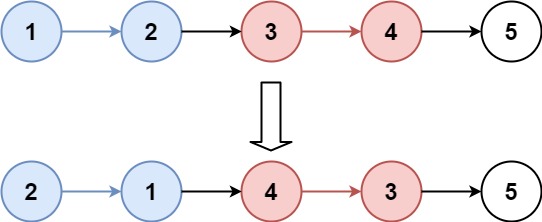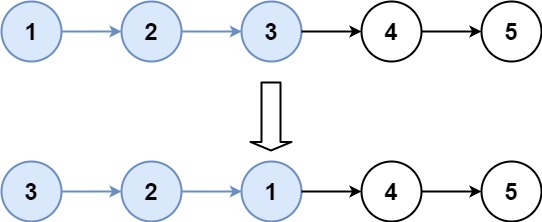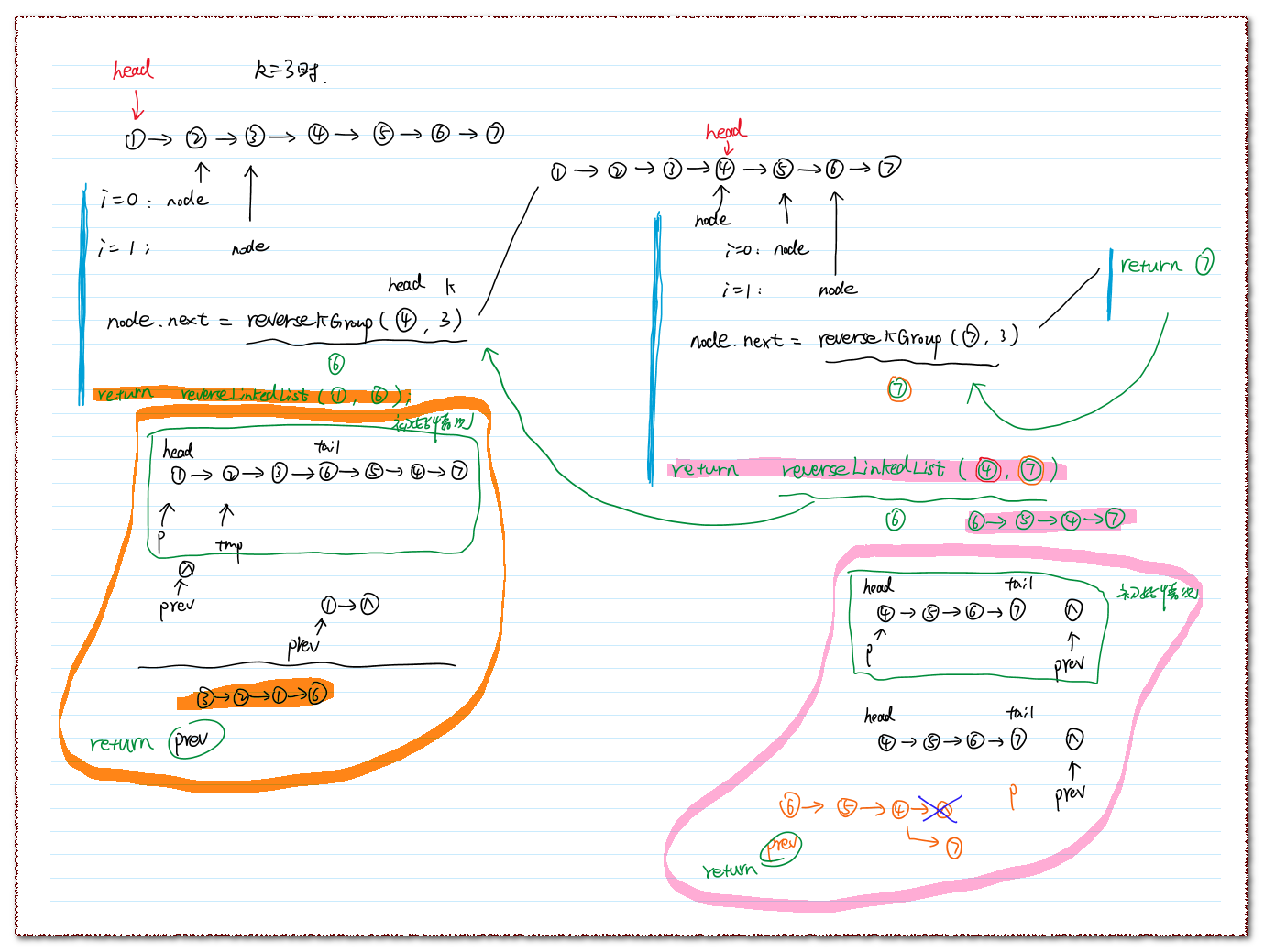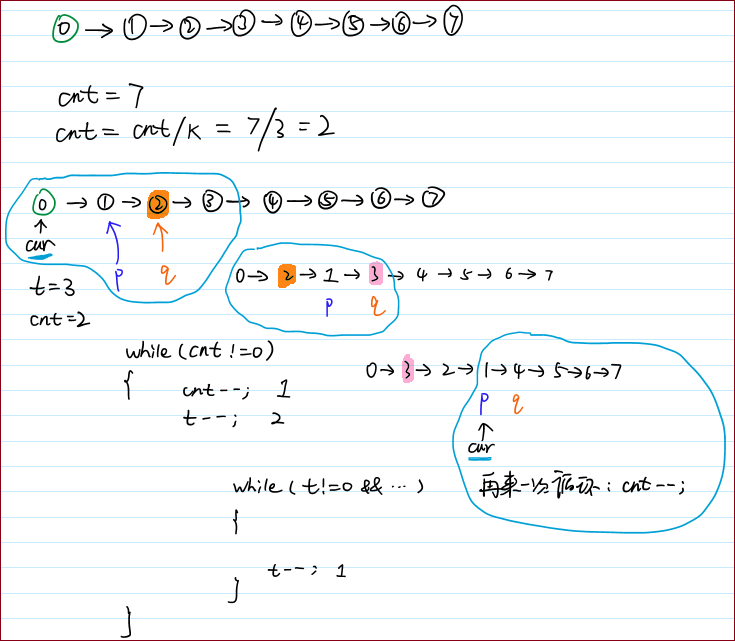[Coding033] LeetCode 25
Reverse Nodes in k-Group
Get the knowledge flowing and circulating! :)
目录
※ 本题收获
递归程序写的很巧妙,需要多看看类似的程序,培养自己的递归思维;
头插法的新写法,用到了
prev这个指针,感觉很新奇;在解法2中,平铺直叙的叙述下,控制大循环的
cnt和内循环的k很值得思考。这个逻辑一开始在写的时候还是比较紊乱的。后来就厘清了!
题目:25. Reverse Nodes in k-Group
Given the head of a linked list, reverse the nodes of the list k at a time, and return the modified list.
k is a positive integer and is less than or equal to the length of the linked list. If the number of nodes is not a multiple of k then left-out nodes, in the end, should remain as it is.
You may not alter the values in the list's nodes, only nodes themselves may be changed.
Example 1:

xxxxxxxxxx21Input: head = [1,2,3,4,5], k = 22Output: [2,1,4,3,5]
Example 2:

xxxxxxxxxx21Input: head = [1,2,3,4,5], k = 32Output: [3,2,1,4,5]
Constraints:
The number of nodes in the list is
n.1 <= k <= n <= 50000 <= Node.val <= 1000
Follow-up: Can you solve the problem in O(1) extra memory space?
代码1(配 · 手绘过程图)

xxxxxxxxxx471/**2 * Definition for singly-linked list.3 * public class ListNode {4 * int val;5 * ListNode next;6 * ListNode() {}7 * ListNode(int val) { this.val = val; }8 * ListNode(int val, ListNode next) { this.val = val; this.next = next; }9 * }10 */11class Solution {12 public ListNode reverseKGroup(ListNode head, int k) {13 ListNode node = head;14 if (node == null) return node;15
16 for (int i = 0; i < k - 1; i++)17 {18 node = node.next;19 if (node == null) return head; // 不够k个,不翻转,直接返回head20 }21
22 node.next = reverseKGroup(node.next, k);23 return reverseLinkedList(head, node.next);24 }25
26 private ListNode reverseLinkedList(ListNode head, ListNode tail)27 {28 ListNode p = head;29 ListNode prev = null;30
31 while (p != tail)32 {33 ListNode tmp = p.next; // 防止链表断裂34
35 // 每次来的新节点放在之前节点的最前面36 p.next = prev;37 prev = p;38
39 p = tmp; // 处理下一个节点40 }41
42 // head自始至终都没变过,指向的是第一个节点(但此时第一个节点已经变成最后一个)43 head.next = tail; // 防止链表断裂,把tail接起来44
45 return prev;46 }47}
代码解读 | 评价
递归程序,每次处理k个,然后依次把处理好的k个连接起来。
目前对其中的
reverseKGroup()这个函数无法特别共鸣,但是可以知道,这个函数每次的head和node.next包裹的内容就是k个待翻转的链表段的(头 和 尾)。一定要多写写这些程序,才能深刻体会到递归的魅力!
值得借鉴的思想
prev这个指针很巧妙,在翻转链表的时候,每次都把新节点放在prev的前面(通过代码
p.next = prev;实现),然后再把新的头结点看成prev(通过代码prev = p;实现);这个比起头插法,显得更简洁明了。(适用于没有
dummy的情况)。
复杂度分析
这个挺快的。
代码2(配 · 手绘过程图)
xxxxxxxxxx561/**2 * Definition for singly-linked list.3 * public class ListNode {4 * int val;5 * ListNode next;6 * ListNode() {}7 * ListNode(int val) { this.val = val; }8 * ListNode(int val, ListNode next) { this.val = val; this.next = next; }9 * }10 */11class Solution {12 public ListNode reverseKGroup(ListNode head, int k) {13 if (head == null)14 return null;15
16 ListNode dummy = new ListNode(0);17 dummy.next = head;18
19 ListNode cp = head;20 int cnt = 0;21 while (cp != null)22 {23 cnt++;24 cp = cp.next;25 }26 cnt = cnt / k; // 看看总共会翻转几轮(7个数,3个一翻转的话,就是2轮,最后一个不翻转)27
28 if (cnt == 0)29 return head; // 少于k个,就不翻转了30
31 ListNode cur = dummy;32 int t = k; // t每轮翻转的时候递减33
34 while (cnt != 0)35 {36 cnt--; // 翻转一轮,减1次;37 t--;38
39 ListNode p = cur.next;40 while (t != 0 && p.next != null)41 {42 ListNode q = p.next;43 p.next = q.next; // 防止链表断裂44 q.next = cur.next; // 新节点安装(装尾巴)45 cur.next = q; // 新节点安装(装头部)46
47 t--; // 总共要处理k个节点,处理一次减1个48 }49
50 cur = p; // 新一轮的head51 t = k; // 新一轮的计数52 }53
54 return dummy.next;55 }56}
代码解读 | 评价
这段代码相对于上一个用了递归思想的代码,就是平铺直叙的书写方式。
需要特别注意
cnt和k的关系
cnt是大循环,k是每次大循环中要翻转的k个元素;e.g., 假如说对于7个节点的链表,如果每波翻转3个节点,则要翻转2波;
即:
k = 3, cnt = 2程序的核心控制就是
cnt和k,但是k每次会更新;
复杂度分析
这个比较慢。

